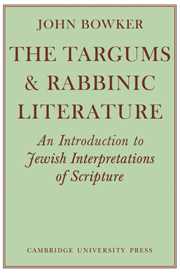Book contents
- Frontmatter
- Contents
- Preface
- Acknowledgements
- Note on the 1979 reprint
- Note on transliteration
- Note on bibliographical references
- List of abbreviations
- INTRODUCTION: THE BACKGROUND OF THE TARGUMS
- PS. JONATHAN ON SELECTED CHAPTERS OF GENESIS
- Appendices
- I The Biblical Antiquities of Philo: a translation of the passages related to Genesis
- II The Seven and Thirteen Rules of Interpretation
- III The Recognised variants in the Septuagint
- IV The Dotted Words in Genesis
- V The Tractates in the Mishnah
- VI Rabbinic Generations
- VII Cairo Geniza Fragments published in Kahle, Masoreten des Westerns, 11, part 2
- Bibliography
- Indexes
IV - The Dotted Words in Genesis
Published online by Cambridge University Press: 01 June 2011
- Frontmatter
- Contents
- Preface
- Acknowledgements
- Note on the 1979 reprint
- Note on transliteration
- Note on bibliographical references
- List of abbreviations
- INTRODUCTION: THE BACKGROUND OF THE TARGUMS
- PS. JONATHAN ON SELECTED CHAPTERS OF GENESIS
- Appendices
- I The Biblical Antiquities of Philo: a translation of the passages related to Genesis
- II The Seven and Thirteen Rules of Interpretation
- III The Recognised variants in the Septuagint
- IV The Dotted Words in Genesis
- V The Tractates in the Mishnah
- VI Rabbinic Generations
- VII Cairo Geniza Fragments published in Kahle, Masoreten des Westerns, 11, part 2
- Bibliography
- Indexes
Summary
A.R.N. 34 summarises the ten dotted words in the Pentateuch, of which five come in Genesis. In origin the placing of dots above particular letters was perhaps meant to indicate that the scribe had made a mistake, or that the reading was uncertain, or that some of the letters might perhaps be changed, but A.R.N. took them as implying something of exegetical importance:
‘The Lord judge between me and thee. The letter y is dotted to show that Sarah spoke to Abraham about Hagar alone; some say it refers to those who provoke arguments “beween me and you”.
And they said unto him, Where is Sarah thy wife? That is to show that they really knew where she was but still asked for her.
And he knew not when she lay down, nor when she arose. That is to show that he did not know only when the younger daughter arose.
And Esau ran to meet him, and embraced him, and fell on his neck, and kissed him. That is to show that he did not kiss him with all his heart. Rabbi Simeon ben Eleazar said that he did on this occasion, but that whenever else he kissed he did not.
And his brethren went to feed his father's flock in Shechem. That is to show that they did not go to feed the flock, but to eat, drink and be merry.’
- Type
- Chapter
- Information
- The Targums and Rabbinic LiteratureAn Introduction to Jewish Interpretations of Scripture, pp. 321Publisher: Cambridge University PressPrint publication year: 1969
- 1
- Cited by



